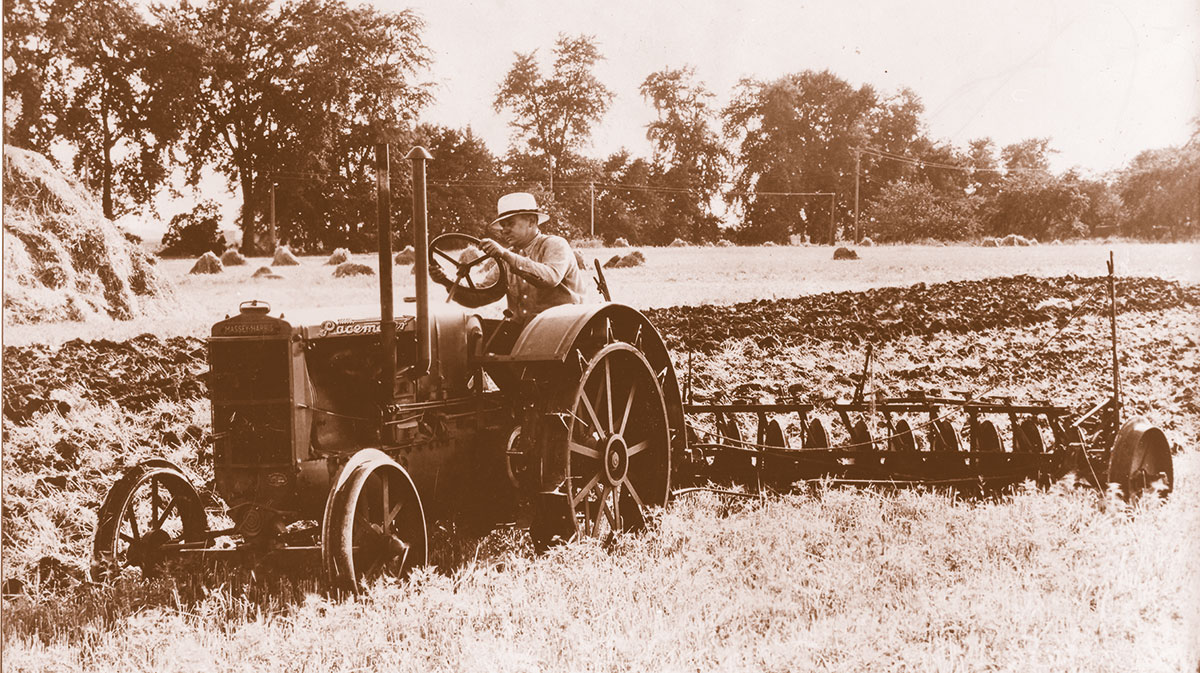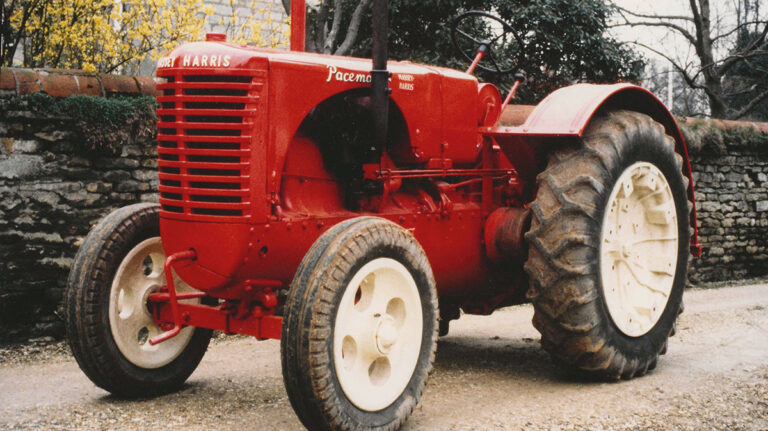Massey-Harris history dates back to 1847 when Daniel Massey began making tools and simple machinery in a workshop in Ontario, Canada, and the next major development followed 10 years later when another Ontario-based machinery pioneer named Alanson Harris opened a workshop with a forge.
Canada’s fast-expanding farming industry provided a growth market, and the Massey and Harris businesses were soon the biggest farm machinery manufacturers in Canada.
See also: Whatever happened to…Overtime & Waterloo Boy?
The businesses merged in 1891 to form Massey-Harris, a company strong enough to compete with the big American farm machinery manufacturers.
The Massey-Harris speciality was harvesting equipment and as well as their Canadian success, Massey-Harris developed export sales to America and other markets worldwide.
World War brings policy change
While demand for field machinery continued to develop and expand, tractors did not feature in the Massey-Harris product list, but the big increase in tractor sales during the First World War brought a policy change.
Massey-Harris agreed to import the American-built Big Bull tractor with three wheels and a 25hp engine. The agreement began in 1917, but few tractors were delivered due to production problems at the manufacturer’s American factory, so lasted less than a year.
For their second tractor venture Massey-Harris took control of manufacturing, and the result was an agreement with the US-based Parrett company, allowing three Parrett tractor models to be built by Massey-Harris and sold under the Massey-Harris name through its Canadian dealer network.
Parrett tractors had achieved some sales success in America, and the Massey-Harris versions, available from 1919, were popular for a while.
The Parrett design included some features that were becoming outdated, and with intense competition from the Fordson, tractor production at both the Massey-Harris and Parrett factories ended after less than four years.

Tractor for Canadian market
Massey-Harris lacked a tractor again, and decided to seek another American tractor for the Canadian market. The partner this time was the J I Case Plow Works Co based in Racine, Wisconsin, and negotiations started in about 1926.
The Plow Works was one of two separate J I Case companies at that time, both established by Jerome Increase Case and both making farm equipment including tractors.
The Plow Works was the smaller of the two and made tractors under the Wallis brand name, avoiding confusion with tractors made by the J I Case Threshing Machine Co and sold under the Case name.
The Wallis name also drew attention to an important design feature known as the Wallis U-frame, a u-shaped casting made of boiler plate steel to provide support for the engine and transmission.
As well as structural strength, the U-frame also provided a dust-, mud- and water-proof underside for the main components. The development was described in an advert as “undoubtedly the greatest invention in tractor history.”
Wallis Tractor sales
Negotiations allowing Massey-Harris to sell Wallis tractors began in 1926 a year later an agreement was reached for Massey-Harris to sell Wallis tractors in Canada and some parts of the US, but this was not the end of the story, because, in 1928, Massey-Harris agreed to buy the Case Plow company.
This caused concern at the other Case company because Massey-Harris could now use the Case brand name, and Massey-Harris was able to sell its right to the name for a substantial sum.
Massey-Harris was now a full line farm equipment manufacturer, continuing to build the 20-30 tractor from the former Case range.
The Wallis brand name was soon changed to Massey-Harris, but the U-frame design feature was retained until about 1940. A new model introduced following the ownership change was the 12-20, arriving in 1929 to provide a smaller version of the 20-30 and sharing the same Wallis styling.
When the new tractor was tested at Nebraska, the performance figures showed Massey-Harris had understated the power output, as the maximum in the tests was 24hp on the belt pulley and 18hp on the drawbar.
Pacemaker tractor
The angular Wallis appearance was retained in 1936 when Massey-Harris introduced the new Pacemaker tractor, which was also available as a row-crop version called the Challenger.
The new models were developed from the 12-20 design, and improvements included engine modifications to boost power output, with the manufacturer claiming 17 and 27hp; and a replacement gearbox providing four speeds.
After only two years, a new version of the Pacemaker arrived with major design changes.
Catchy colours
Previously, through almost 50 years of tractor history, development had concentrated on engineering features to boost efficiency and output in the field, but a major change in the mid-1930s was a new emphasis on appearance with previously subdued colours replaced by a brighter, more eye-catching paint finish and with more rounded styling influenced by the increasing popularity of streamlining in the car industry.
The new look arrived first in America, and Massey-Harris employed a leading industrial stylist to give its tractors a new look.
The result, including a bright new red paint finish, made its first appearance on the Pacemaker, which became known as the Streamlined Pacemaker.
The list of options available on the new-look version of the Pacemaker included a rear power lift for mounted implements, and customers could choose either a standard gearbox with a 7.5mph top speed or the high ratio version providing a modest boost to about 8.5 mph.
An additional feature available on petrol powered Pacemakers and recommended only for belt work, was Twin Power allowing the driver to boost the maximum engine speed to 1,400rpm instead of 1,200.
A new 101 tractor model introduced by Massey-Harris in 1938 was the start of a programme to replace the tractors developed from the former Wallis range, including the Pacemaker, and the new range had taken over by the early 1940s.


